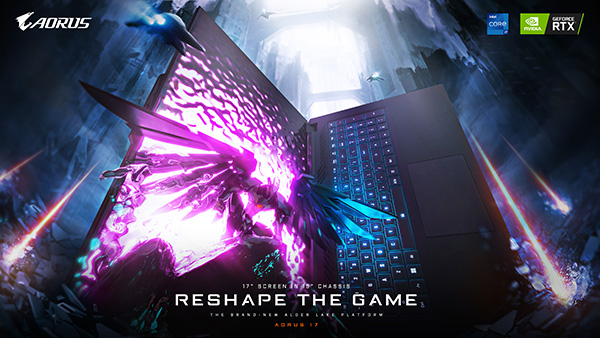Gigabyte Announces New Alder Lake Aorus Laptops
Gigabyte has introduced three new Aorus laptop models for 2022, including some high-refresh-rate models.
Gigabyte has announced the availability of three more laptops under its Aorus gaming brand. The Aorus 17, Aorus 15 and Aorus 5 cater to different audiences, but all of them are based on Intel’s Alder Lake platform paired with Nvidia RTX graphics – and aim to “reshape the game” by delivering enjoyable gaming experiences in a mobile form factor.
All of the Aorus laptops here pack the same Intel silicon under the hood: an Alder Lake Core i7-12700H, offering up 14 cores in total (six performance cores paired with eight efficiency cores) and 20 logical threads (Hyper-Threading is enabled in the P cores). The chip achieves a 4.7 GHz Boost clock on its performance cores, while keeping within a 45 W TDP. Gigabyte claims a 90% screen-to-body ratio throughout its new laptop series, achieved via a four-sided bezel-less design. All of the laptops carry Dolby’s DTS: X Ultra certification for immersive soundscapes, as well as support for Wi-Fi 6E and its expanded 6 GHz band.
| Row 0 - Cell 0 | AORUS 17 | AORUS 15 | AORUS 5 |
| CPU | Intel Core i7-12700H (6x P-cores, 8x E-cores, 20T) | Intel Core i7-12700H (6x P-cores, 8x E-cores, 20T) | Intel Core i7-12700H (6x P-cores, 8x E-cores, 20T) |
| GPU | Nvidia GeForce RTX 3080 Ti 16 GB (up to) | Nvidia GeForce RTX 3080 Ti 16 GB (up to) | Nvidia GeForce RTX 3070 8 GB (up to) |
| Display options | FHD 360 Hz | QHD 165 Hz; FHD 360 Hz | FHD 144 Hz; FHD 240 Hz |
| Memory | DDR5-4800 | DDR5-4800 | DDR4-3200 |
| Storage | M.2 2280 x2 (1x PCIe Gen4x4) | M.2 2280 x2 (1x PCIe Gen4x4) | M.2 2280 x2 (1x PCIe Gen4x4) |
| Audio | DTS: X Ultra | DTS: X Ultra | DTS: X Ultra |
| Wireless connectivity | Wi-Fi: Intel AX211 (CNVi), BT 5.2 | Wi-Fi: Intel AX210 (PCIe), BT 5.2 | Wi-Fi: Intel AX211 (CNVi), BT 5.2 |
| Dimensions (cm) | 39.8 (W) x 25.4 (D) x 2.4~2.7 (H) | 36 (W) x 24.4 (D) x 2.4~2.7 (H) | 35.8 (W) x 25.4 (D) x 2.4~2.7 (H) |
| Weight | ~2.3 kg | ~2.4 kg | ~2.7 kg |

Starting from the highest-tier offering, the Aorus 17 is being marketed towards the “Extreme Gamer” segment. Due to the 90% screen-to-body ratio, the Aorus 17 offers a 17.3” screen in a 15.6” form-factor, adding convenience and mobility. It can be configured with up to an Nvidia RTX 3080Ti mobility GPU (130 W) with 16GB of GDDR6 VRAM. Its display offers a limited 1920 x 1080 display, but with an aggressive refresh rate of 360Hz. The RTX 3080 Ti and Core i7-12700H CPU are more than adequate to deliver high-refresh-rate gaming in such a configuration. To this end, the DDR5-4800 memory subsystem should bring higher performance than DDR4 implementations, despite it being the slowest possible DDR5 memory speed according to JEDEC standards. As for storage, a pair of M.2 2280 slots is available for ultra-fast solid-state storage, with a single M.2 port offering x4 PCIe 4.0 lanes. Finally, Aorus' RGB Fusion is present for brightly lit gaming sessions, with a per-key RGB lighting system.
The Aorus 15 is being targeted at “Enthusiast Gamers”, and shares much of its DNA with its more extreme sibling. It too can be configured with up to an RTX 3080Ti and offers an up to DDR5-4800 memory subsystem; where the differences lie is in the form factor (15.6” vs 17.3”) and display options. The Aorus 15 actually offers more choice in this department, with users being able to configure the laptop with either a 165Hz QHD (2560 x 1440) panel, or the same 360Hz FHD panel that’s found in the Aorus 17. All other specifications remain the same between the two options.

The Aorus 5 stands as the entry-level offering, targeted at “Performance Gamers”. Built in the same 15.6” form-factor as the Aorus 15, the Aorus 5 cuts some corners in order to achieve a more palatable pricing. While it keeps the same Intel Core i7-12700H CPU as the other entries, the maximum configurable graphics card tops out at an Nvidia GeForce RTX 3070 mobility GPU (130 W, 8 GB GDDR6). It also trades the DDR5 memory for DDR4-3200, which should contribute towards a significant reduction in the bill, with a corresponding drop in performance.
The Aorus 5 also features two display options distinct from those available in the rest of the line-up: it can be configured with either a 240Hz or 144Hz FHD panel. A gamer who prioritizes AAA experiences might opt for the 144Hz panel, while another that’s more in-tune with eSports titles might prefer the faster refresh rates of the 240Hz option. With all else being equal, higher panel refresh rates mean lower battery life, so you should keep that in mind when weighing your options. Another cost-cutting measure relates to the RGB Fusion lighting system: it loses the per-key RGB, scaling down to a three-zone lighting solution. But that's it: hardware-wise, it's an extremely competent on-the-go gaming machine.
No word on pricing was available at time of writing, but the Aorus 2022 series should be available through the usual retailers and e-tailers soon.
Get Tom's Hardware's best news and in-depth reviews, straight to your inbox.

Francisco Pires is a freelance news writer for Tom's Hardware with a soft side for quantum computing.